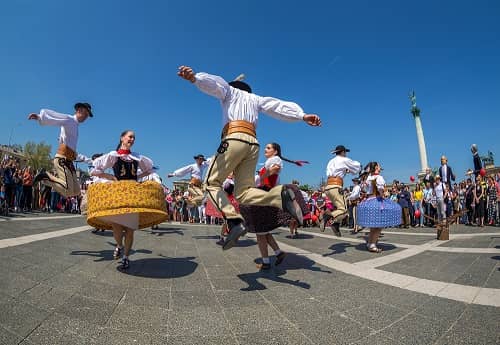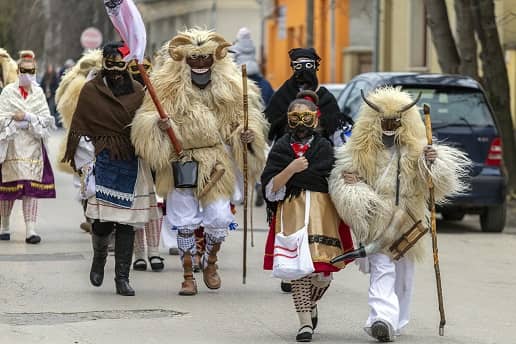The awakening nature calls us to wake up too and shake off the winter’s melancholy. February is the month of various vivid carnivals and feasts. Have you heard of Farsang – the Hungarian Carnival or the Busójárás? Have you ever tried the carnival doughnut or blessed with holy water? Here is a list of our essential traditions – let’s check them out!
The day of Epiphany (6 January) marks the end of the Christmas feast and the beginning of saying goodbye to winter and looking forward to spring. In the old days, Hungarian people went to the church and took a jar or a bottle with themselves to fill them with holy water, and in the morning, they started the day by crossing themselves using this water. Believers very often poured it onto their livestock and treated diseases. Traditionally, the local priest goes through the village and performs rites to protect the inhabitants’ houses from misfortune. They also blessed the rivers and streams to avoid floods and to help the farmers with water.
On the other hand, costume parades and carnival masks mark the formal farewell to winter all around the world and Hungary is no exception, but has numerous local characteristics. The carnival season usually starts in February, and lasts up until Ash Wednesday (this year on 17 February) when Lent begins right before Easter. As opposed to the modest diet of Lent, the period of Farsang has a rich menu of sweets and meats. One of the signature delicacies of this period is the carnival doughnut (Szalagos Farsangi Fánk), a sumptuous treat that is fried in shallow oil, flipped with a light ribbon of pastry around the middle, and then filled with cream or apricot jam and dusted with powdered sugar.

In the medieval era of Hungary, carnivals were extremely popular and were excellent events to meet new people and to find your future husband or wife. This is why the main factor of these celebrations was getting engaged. The most popular costumes were usually musicians, knights, fairies, princes, princesses, while others dressed up as a butterfly or a clown – all of which left a mark on the general theme of the modern-day Farsang carnivals as well. The high-point of Farsang is its last three days, called Farsang Farka ("the tail of Farsang") and lasts from the so-called Farsang Sunday until Shrove Tuesday (or "Húshagyókedd" in Hungarian). In 2021 Farsang Farka will be between 14-17 February.

In some parts of the world, like in Venice or Rio, the annually-held carnivals are organized around this time of the year, while in Hungary, the most outstanding celebration is the Busójárás in Mohács. The UNESCO-recognised event lasts 6 days in the small town of Mohács, located in southern Hungary, near Pécs. Busós are traditionally men wearing scary costumes, unique wooden masks, and woolly cloaks made of sheepskin. They like to chase around and circulate among the crowd while pulling pranks and making big noise as a symbol of scaring away winter.
A legend holds that at some point, the local Šokci (a South Slavic ethnic group from Croatia) fled from Mohács to the nearby swamps and woods to avoid the Ottoman troops. One night an old man appeared and was advised to create scary, fearsome masks and make rattling and clattering objects to scare away the Ottomans. At night, the Šokci crossed the river Danube with their boats and chased the Turks away. Despite the fact that the story has no real historical foundations, the legend of busós is still very popular among the townspeople.

In ancient times, busós walked from house to house to express their good wishes, to practice magic and in exchange to receive drinks and food gifts. Today, most of the folk custom’s origin has been lost but has gained with numerous other attractions. It is a real End-of-Winter festival with such events as the crossing of the Danube in large ferry boats or the sinking of Old Man Winter’s coffin in the river.
Although this year’s carnivals and feasts were cancelled due to the pandemic, you can say goodbye to the cold season and welcome the arrival of spring!
Sources:
HungaryToday ; WeLoveBudapest; Expat-press.com; UNESCO; atlasobscura.com; Mohácsi Busójárás Official
Corinthia - FARSANG: THE BUDAPEST CARNIVAL SEASON
We Love Budapest – How to celebrate carnival season in Budapest and beyond
Kellemesünnepek.hu – Mikor van farsang 2021-ben
Daily News Hungary – Carnival season in Hungary – Costumes and traditions
Lonely Planet – Spotlight on: Hungary’s carnival season